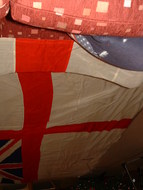U.K. White Ensign Made at the New York Navy Yard, 1891
This large, wool, hand and machine sewn flag is a Royal Navy White Ensign. What makes this particular ensign noteworthy is that it was not made in the United Kingdom, but in New York City. U.S. Navy Yards made many of their own flags from the 1800s through the 1900s. They made sails, hammocks, mattress covers, sea bags, and canvas tarps in what they called a "sail loft". Many of these Navy Yards had a "flag loft" as well, in which they would make flags, ensigns, jacks, pennants, and signal flags. These flag lofts would also make various foreign flags and ensigns that the larger U.S. Naval ships might have needed.
Prior to the American Civil War manufacturing information began to be printed on the flags. This would include the identification, manufacturer, size, and fabrication date. In the 19th Century, each Navy Yard was under independent command, and serviced different squadrons. This led to there being little uniformity in the abbreviated codes that was used to facilitate inventory, manufacturing, and quality control.
The stenciled markings on this white British ensign indicate that it was made in September of 1891, in the New York Navy Yard, and that it is the standard Navy size 2 ensign. The stenciling says, "No. 2; Navy Yard; N.Y.; Sept.; 1891."
U.S. Naval vessels would have used United Kingdom ensigns when visiting British ports, or its protectorates. The ensigns would have been used as a courtesy to show respect. Foreign ensigns would have been kept on U.S. Naval vessels any time they would travel to a foreign port. The ensign would customarily have been worn at the foremast head, or at the starboard yardarm or crosstree of the mainmast, depending on the vessel's rigging.
British Admiralty used a Red Ensign that was the same color as the Civil Ensign in the U.K. In 1864 the color of the Royal Navy ensign was changed to white to avoid confusion. Vessels from the Empire serving with the Royal Navy also used the White Ensign.
U.S. Navy Yard made flags are rare since they were usually discarded when no longer serviceable.
ZFC IMPORTANT FLAG
Sources:
Flag Sizes, Naval History & Heritage Command, 19 June 2013, from: http://www.history.navy.mil/faqs/faq129-1.htm
History of the BNY, Brooklyn Navy Yard Development Corporation, 19 June 2013, from: http://www.brooklynnavyyard.org/history.html
Zaricor Flag Collection (ZFC) Archives, 2013.
Image Credits:
Zaricor Flag Collection
RTZFC





















